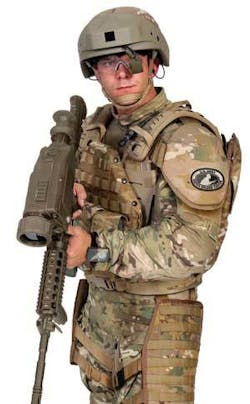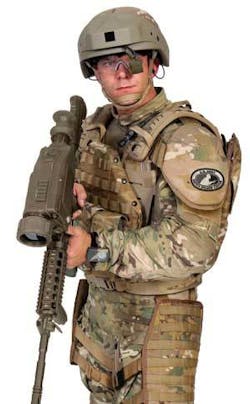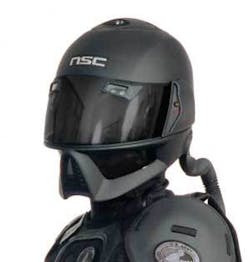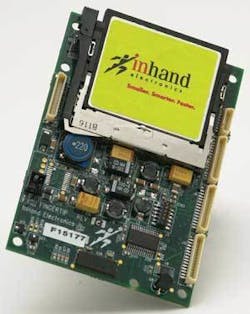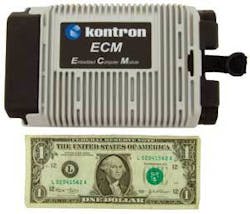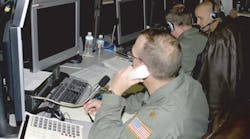Today’s warfighters are all becoming cogs or nodes in one digitized network force, and wearable computers patch them into the network.
By John McHale
The phrase “wearable computing” can generate many images to the average person-from handheld computers to bionic arms on the Borg cyborgs on Star Trek.
Military devices are much more a combination of PDAs and rugged computers because they are essentially a communication device that patches in warfighters to the networked force. The computers provide them with tactical information such as Blue/Red Force tracking and intelligence information from Unmanned vehicles-all in real time. The overall goal is situational awareness, where the warfighters can see what everyone else sees.
The key ingredients among all these computers are low-power, small size, low weight, and customization.
Size and weight are obvious concerns, yet wearable computing seldom has a standard fit. This is the reason that flexibility is so important, says Randy Wisebrod, sales technical support manager for mobile rugged products at Kontron in Fremont, Calif. Kontron’s rugged ECM computer is customizable for applications with special needs for I/O requirements, he adds.
Wisebrod declined to comment on specific military applications for the ECM, however, he did say the Kontron device is well-suited to video communications in improving situational awareness on the battlefield.
The Kontron ECM houses control boards within a secure module and can be carried, mounted, embedded, or worn. It features a range of Intel Pentium M processors, 1 gigabyte of DDR RAM, integrated 802.11b wireless networking capabilities, and a rugged, removable 40-to-60-gigabyte hard drive.
The ECM has a small footprint-about the size of a brick-and uses a Pentium 1.4 GHz microprocessor, Wisebrod says. It also meets MIL-STD 810 specifications, he adds.
Ross Q. Smith, president and co-founder of Quantum3D in San Jose, Calif., says he also sees video processing as a key requirement, especially with the video reconnaissance coming from unmanned aerial vehicles (UAVs). Soldiers need to be able to see what the UAVs see, as they see it, he adds.
The most well-known application for wearable computers in the military is the Land Warrior program, which is part of the U.S. Army’s Future Force Warrior program.
The first phase of the Future Force Warrior program is to reduce the soldier’s load weight and power requirements, while improving his or her lethality, situational awareness, communicability, and protection. To this end, the Army not only is conducting its own research and development, but also eliciting the help and technologies of various industry vendors.
Part of this research includes the Land Warrior demonstrations. The Land Warrior Ensemble is an integrated soldier-fighting system intended to improve the fighting ability of infantry soldiers who ride in vehicles or walk on the ground as part of the Stryker Brigade Combat Team. It helps soldiers share battlefield information at least in part by digitally networking individual soldiers with other platforms.
One of the small, low-power devices used is the Thermite Tactical Visual Computer from Quantum3D.
“The unique features, low weight, power consumption, and ability to be configured for our specific needs were key factors we considered when we selected the Thermite systems for the Land Warrior data collection mission,” says Curtis Austin, the U.S. Army Operational Test Command (USAOTC) Electronics Engineer. “Thermite is well-suited for deployed communications data collection and has proven to be very reliable in the field while not interfering with the soldier because of their compactness.”
The USAOTC selected the Thermite Tactical Visual Computer for use in the operational test and evaluation of the Land Warrior Ensemble during the upcoming limited user test. The Army testers plans and conducts independent operational testing and experiments in order to provide essential information for the decision-making process. The USAOTC supports the Army material acquisition and force development processes by managing the user testing program and conducting operational testing to support continuous comprehensive evaluation and force development. For more information on the USAOTC, visit www.otc.army.mil.
The Land Warrior limited user test evaluates the effectiveness and suitability of soldiers when deployed with and without the Land Warrior Ensemble, Quantum3D officials say. To measure key performance parameters, personnel at the USAOTC have integrated the Thermite Tactical Visual Computer into the man-wearable Land Warrior Ensemble to perform real-time data collection on the performance of the Land Warrior Ensemble’s Combat Net Radio System (CNRS) and Computer Subsystem (CSS).
Integrated into the Land Warrior Ensemble, the battery-powered Thermite-based data collection system can record 10 hours of real-time communications and related data on the Land Warrior Ensemble while deployed in a tactical maneuver operational environment without adding significant weight to the overall system. The collected data will be employed by USAOTC Research Analysts for input into the Land Warrior limited user test evaluation process.
The Land Warrior limited user test was to begin in September using troops from the 4th Battalion, 9th Infantry Regiment, “Manchu”, based at Fort Lewis, Wash. The USAOTC has used Thermite systems in previous Land Warrior Ensemble operational testing events, including Verification and Validation trials at Fort Huachuca, Arizona, and System Integration Tests conducted at Fort Lewis, Washington, company officials say.
“Operational test and evaluation are critical milestones in the development and deployment of military systems,” Smith says. “Without proper testing, it’s difficult to really know how well a new system will perform in battlefield environments.”
Telephonics Corp. in Farmingdale, N.Y., also has selected the Thermite Tactical Visual Computer for use in the Technology Demonstration of the Mounted Warrior Multi-Media Communications during the Association of the U.S. Army’s Annual meeting in Washington last month.
The Mounted Warrior Ensemble is an integrated soldier-fighting system to improve the fighting ability of infantry soldiers who ride in vehicles or walk on the ground as part of the Stryker Brigade Combat Team. The Mounted Warrior Ensemble is designed to facilitate sharing of battlefield multimedia information and to integrate individual soldiers for interoperability with the digital command and control of other platforms.
The purpose of the Mounted Warrior demonstration is to show multimedia integration capabilities of low-data-rate video sources such as driver video enhancement, FBCB2 data, soldier SA/Recon and weapons targeting video.
Thermite provides the man-wearable rugged PC platform for the dismounted soldier to relay through the TruLink short-ranged-radio technology video/images to and from Stryker or other vehicles. The Mounted Warrior ensemble uses the battery-powered Thermite-based multimedia communications system to display on the soldier’s head-mounted monocle or via LCD.
Thermite Tactical Visual Computer is Quantum3D’s small form factor, off-the-shelf, real-time tactical PC that combines low-power, mobile CPU technology with advanced embedded 2-D/3-D graphics with video capture and display, and comprehensive I/O and wired/wireless communications capabilities in a ruggedized, sealed alloy enclosure with Mil-Spec connectors that is optimized for hosting C4ISR, C2, embedded training and other graphics and video intensive applications in both man-wearable and vehicle-based deployed environments.
The Quantum3D device is designed to enable the rapid migration of PC-based applications from benign to extended environments and to reduce the footprint of legacy embedded systems. It also supports Microsoft Windows and Linux operating systems.
For surveillance and sensor applications, the device includes advanced video-capture and video-display functionality, with support for color space conversion, scaling, and overlays for NTSC, PAL, S-Video, and RS-170A formats.
The Thermite Tactical Visual Computer is available with solid-state and shock-resistant rotating disk drives and features PC I/O and networking such as IEEE 802.3 Ethernet, USB 2.0, RS-232C, IEEE 802.11 and Bluetooth. Thermite is also available with popular military and civilian communications and I/O factory options including Mil-Std-1553B, EVDO, GPRS, Tactical/Secure Radios, CANBus, and GPS.
Underwater RPDA
Engineers at Ocean Integrated Technologies of Rosh Ha’ayin, Israel, and In-Hand Electronics in Rockville, Md., solved size, weight, power, and ruggedization challenges in deploying an underwater ruggedized personal digital assistant (RPDA) to U.S. Navy Seals.
This portable navigation and safety device was developed to help military or commercial divers and submersible vehicles, Ocean officials say. The RPDA can be mounted on an arm, hand carried, or attached to a swim board and it provides as many as eight hours of continuous use in a fully active state, all while providing the user with 12 GPS channels, depth and heading sensors, and the durability to meet the most stringent military durability standards.
The RPDA comes equipped with a thin-film transistor display that provides 640-by-480-pixel resolution or better, is submersible as deep as 50 meters, and functions from -20 to 45 degrees Celsius. Three RS232 and IR connections are also available onboard to give the user the ability to update the RPDA with the latest software releases.
“The cornerstone of the RPDA, the Fingertip3 by InHand, has provided us with the necessary peripherals and the rugged stability to allow us to develop a unit that meets or surpasses the rigors of the military standards” says Yehuda Harel, spokesman for Oceana.
At the core of the RPDA’s durability and functionality is the Fingertip3 single board computer. It is one of the smallest handheld solutions around, measuring 60 by 86 millimeters.
The device has onboard GPS, Bluetooth, USB, battery charging and an array of available serial ports and I/O pins. The Fingertip3 is also low-power, consuming as little as 350 milliwatts in full-functional mode with the help of InHand’s BatterySmart system software.
Designed for developers of handheld devices who need the smallest, lowest power-consumption platform possible Fingertip3 is based on Intel’s PXA 255 XScale CPU, providing as much as 400MHz of processing power. With a minimum input voltage requirement of just 3.6 volts DC, Fingertip reduces battery size requirements and supports an array of standard peripherals and a variety of LCD displays through multiple on-board interfaces. Peripheral support has been extended with the addition of a secure digital slot (for secure digital memory cards) in addition to a compact flash slot, synchronous serial interface and a network synchronous serial port.
Fingertip3 has been designed for integration into custom products. The Fingertip3 Development Platform provides the starting point for Fingertip3-based designs and comes complete with all the hardware, software, and documentation needed to start development. Engineering Services are also available for custom projects or packaging needs.
Power is the main challenge for designers of wearable systems in the future, which is why technology such as BatterySmart is so important, says Andrew Girson, InHand Electronics’ chief technology officer. Battery technology is not keeping up with user demand.
“BatterySmart is a real-time system-level power-management software package for embedded wireless devices such as wearable computers, handheld PDAs, smart phones, smart sensors, etc.,” Girson says. “BatterySmart incorporates patent-pending dynamic run-time algorithms that interpret embedded system performance parameters such as bus and processor activity, and adjusts other parameters such as processor clock frequency and core voltage so as to maximize battery life while minimizing any performance degradations.”
“A good analogy for BatterySmart is the transmission in your car and whether it is an automatic or manual transmission,” Girson explains. “In a manual transmission, you as the driver determine when to shift gears and adjust performance, whereas in an automatic transmission, the automobile does the thinking. BatterySmart is very much like an automatic transmission. In other words, instead of you as the user or application software developer of the device having to figure out when to make adjustments to performance (such as clock speed), which can occur many times per second, the BatterySmart algorithms figure this out for you, using very low-level, kernel-level adjustments in the operating-system software. The result is that the device operates much more smoothly and there is little need for retrofitting or otherwise adjusting software drivers or application software.”
BatterySmart also includes a complete Application Programming Interface (API) that allows software developers to receive power and performance information and adjust parameters as desired.
The BatterySmart software suite and application programming interface (API)-which are available on the Elf and Fingertip platforms-include these state-of-the-art CPU and power-management technologies: startup CPU speed adjustment, advanced idle mode, dynamic CPU speed adjustment, performance-tuned core software drivers, and optimized peripheral software drivers.
Saft receives order to power communications devices for the U.S. Military
The U.S. Department of Defense placed an order with Saft in Valdese, N.C., for its enhanced BA 5590 lithium-sulfur dioxide (Li-SO2) batteries. The BA 5590A/U model features a new state of charge indicator (SOCI), which is an addition to the existing BA 5590B/U battery. Both versions will continue to be available to meet the needs of military field communication applications.
The U.S. Army Communications-Electronics Life Cycle Management Command (CELCMC) recently standardized the specifications for the BA 5590A/U battery to include the state of charge indicator. Saft is currently the first, and only, manufacturer to offer a qualified BA 5590A/U with SOCI, based on the new standardization in MIL-PRF 49471B, company officials say.
The state of charge indicator enables the soldier to determine the amount of capacity that remains in the battery and will prevent waste of partially spent batteries. Without this technology the soldier would typically use a new battery every time he or she went on a new mission to ensure that there would be enough power, Saft officials say.
The BA 5590 battery powers many types of communication devices used in combat throughout the armed services. Saft is a major supplier of BA 5590 B/U batteries to the U.S. military and the Li-SO2 chemistry is the most commonly used lithium technology with a significant proven record in combat situations; it also is the most cost-effective solution on the market.
“This order strengthens Saft’s position as a leading supplier of advanced battery power for military applications,” says Thomas Alcide, Saft Specialty Battery Group General Manager. The “field-proven BA 5590 batteries” will continue be the base for even more reliable and light-weight power solutions for soldiers, he adds.
Saft’s Valdese facility provides portable power in multiple lithium battery technologies including Li-SO2, Li-MnO2 and Li-ion. For more information, visit Saft at www.saftbatteries.com.
Microvision to develop HMD for Army Mounted Warrior system
Microvision in Redmond, Wash., is developing for General Dyna mics C4 Systems full color helmet-mounted displays for the U.S. Army’s Mounted Warrior Soldier System.
The improvement program, managed by the U.S. Army’s Project Manager for Soldier Warrior under Program Executive Office Soldier, has tapped Microvision to create a full-color HMD system with reduced size, weight, and power requirements. The contract specifies the development, design, verification, testing, and delivery of ten full-color display units for evaluation by mid-2007.
Mounted Warrior is an integrated soldier system designed for armored vehicle crewmen. It integrates communications and displays with soldier mission equipment for crew members, including vehicle commander, driver and gunner. General Dynamics holds prime contracts with the U.S. Army for other Warrior programs including Land Warrior, Mounted Warrior, Air Warrior and Future Force Warrior Advanced Technology Demonstration.
“The U.S. Army and General Dynamics are focused on finding new technologies to be integrated into warrior systems to enhance soldier survivability, mobility, sustainability and overall effectiveness, says Alexander Tokman, Microvision chief executive officer. Microvision’s product’s high-resolution display quality, small form-factor, and cost effectiveness can play a large role in these efforts, he adds.
Microvision expects to deliver an HMD solution that will enable a combat vehicle crew member to see real-time data and video from multiple sources, in true full-color with complete, transparent capabilities, designed with simplicity and comfort, company officials say.
For more on Microvision visit www.microvision.com
InHand announces Advanced Technology Platform for Monahans Platform Family
InHand Electronics, Inc., in Rockville, Md., announced its new Advanced Technology Platform (ATP) for Windows CE, a hardware/software reference platform for showcasing the future of low-power wireless device technology. The ATP is based on Intel’s newest processor family (codenamed Monahans) based on third generation Intel XScale architecture and incorporates InHand’s most recent power management technology advances. It is targeted at top-tier OEMs who are interested in getting a head start on the design of next-generation intelligent handheld and wireless products.
“InHand’s new ATP platform is ideally suited for those companies that are looking to fast-forward their development of new handheld and wireless devices,” says Andrew Girson, InHand Electronics’ chief technology officer. “Along with InHand’s design services in support of the Monahans platform family, the ATP is specifically focused on providing a strong starting point for exploring next-generation designs.”
“The Monahans platform family offers a wide range of performance, power and integration levels, enabling InHand to develop an ATP board-level platform with unique capabilities in terms of size, feature set, and low-power operation,” says Scott McCormack, marketing manager for Intel’s Handheld Platforms Group. “Combined with InHand’s design services capabilities, the ATP provides a significant entry point for developers of the next wave of groundbreaking mobile wireless products.”
The ATP benefits from InHand’s power-reducing hardware and software technologies and also incorporates new wireless device peripherals and interfaces, including WiFi, Bluetooth, and GPS. Additional peripheral interfaces include Ethernet, USB Host, and multiple Compact Flash and SDIO sockets. InHand’s BatterySmart power management software and developer board support packages for the Microsoft Windows CE 5.0 operating system will be available for ATP customers.
InHand also just released and updated version that includes enhanced bus interfaces for extended wireless peripheral support and additional interfaces for new LCD displays and graphics.
“The updated version of InHand’s ATP platform is ideally suited for those companies that are looking to speed-up their development of new handheld and wireless devices,” Girson says “The new ATP includes better wireless and graphics interfaces in support of high-end handheld device design.”
